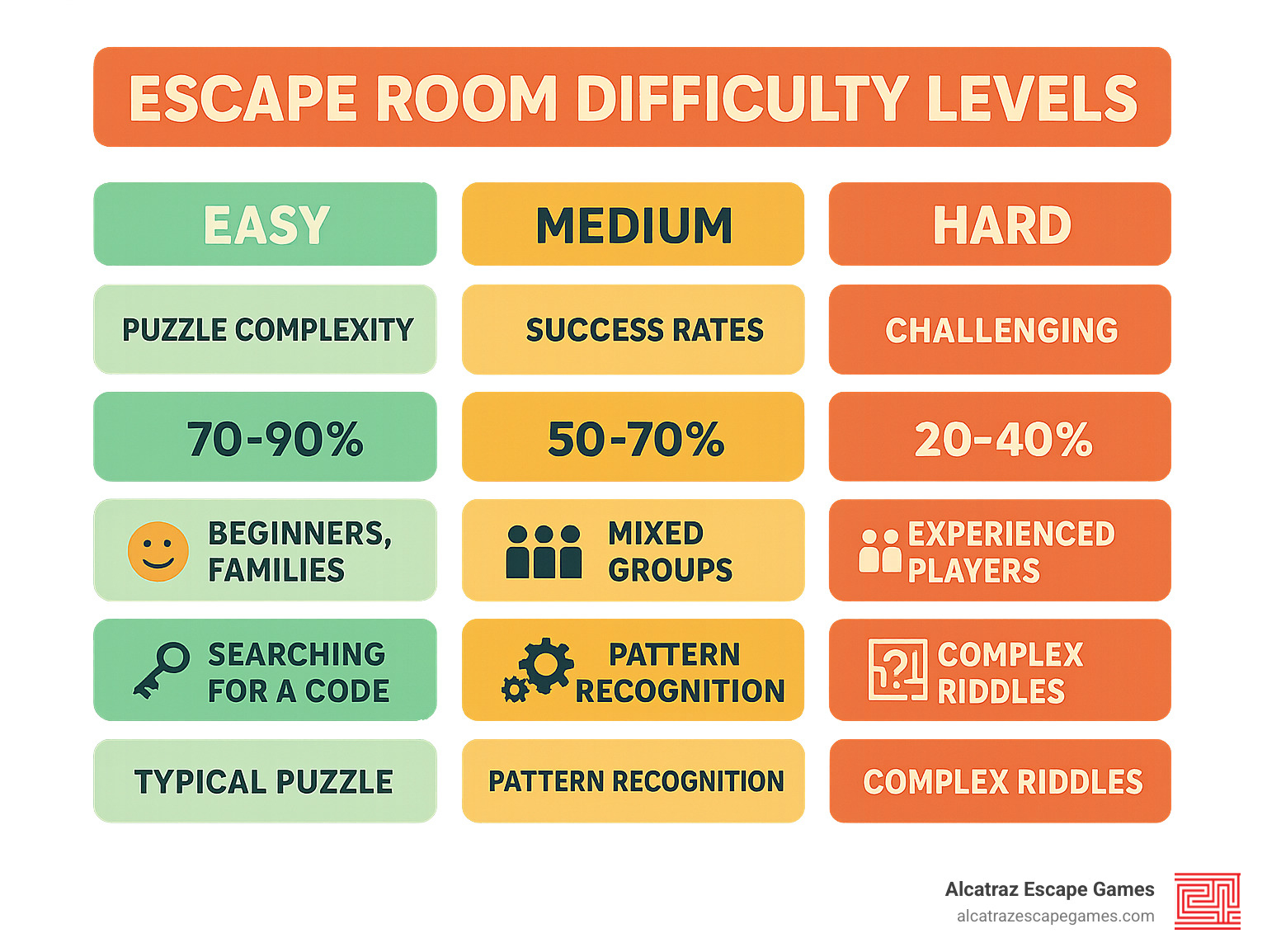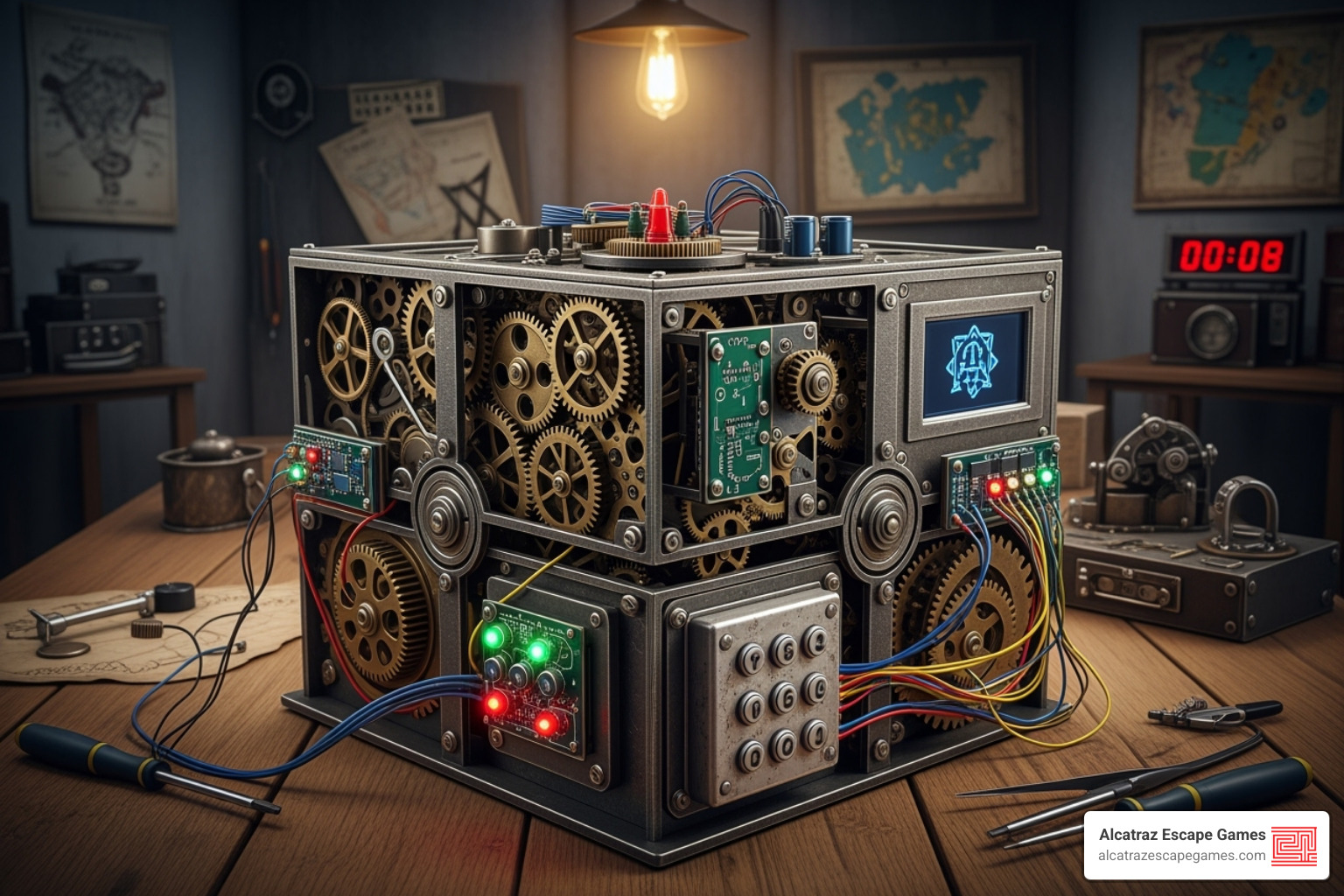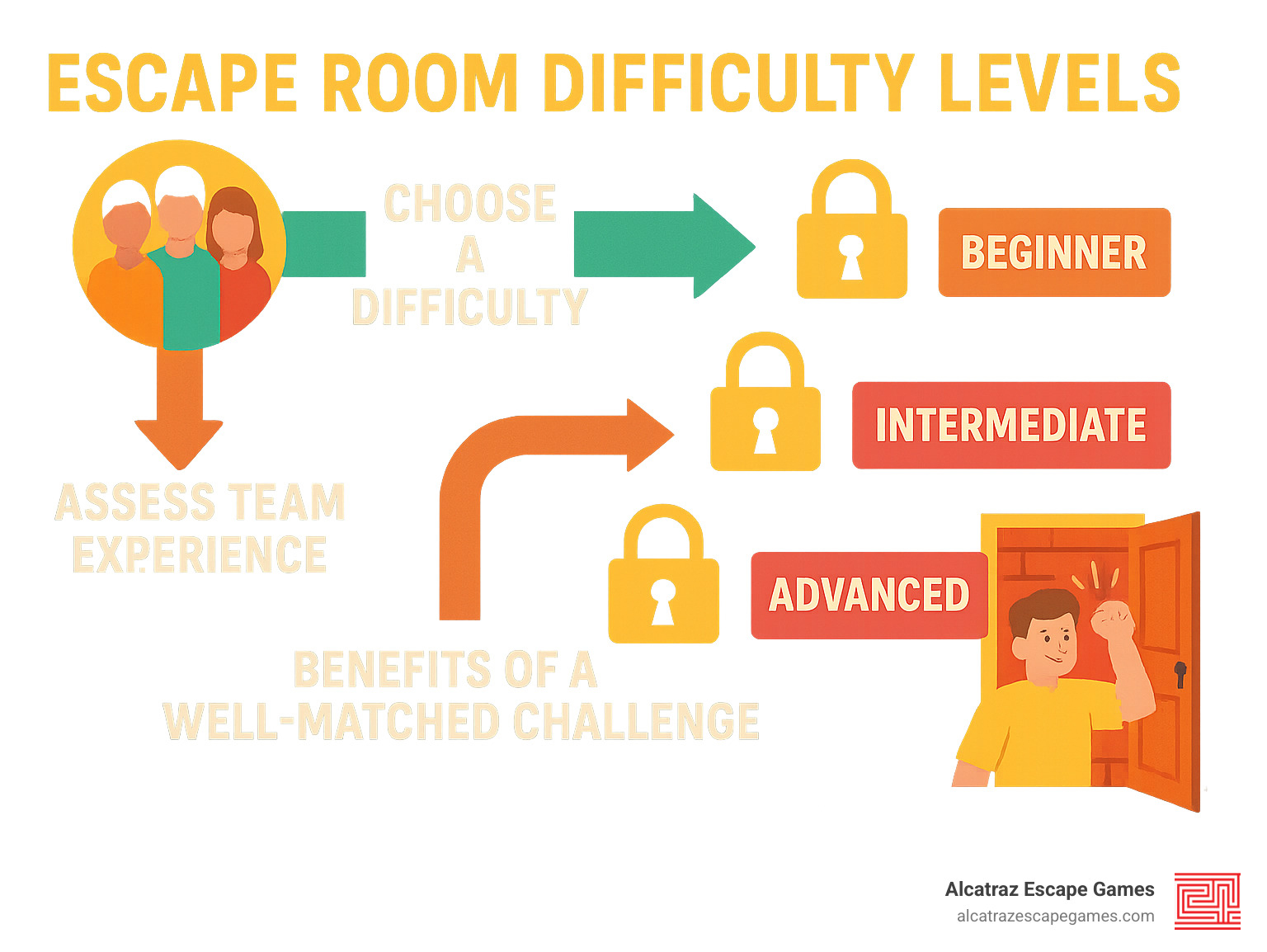Easy, Medium, or Impossible? Your Guide to Escape Room Difficulty Levels
Why Understanding Escape Room Difficulty Levels Matters
Escape room difficulty levels are key to having an amazing experience instead of a frustrating one. Most escape rooms use a simple rating system to help you choose the right challenge:
- Easy/Beginner (1-3/10): Perfect for first-timers, families, and casual fun.
- Medium/Intermediate (4-6/10): A balanced challenge for mixed groups with a 50-70% success rate.
- Hard/Advanced (7-10/10): Complex puzzles for experienced players with a 20-40% success rate.
The difference isn't just puzzle hardness. Easy rooms have straightforward logic, while hard rooms demand abstract thinking, layered puzzles, and serious teamwork.
But difficulty isn't just about the puzzles. Room design, red herrings, puzzle flow (linear vs. non-linear), and your team's communication all affect how challenging a room feels.
Choosing the wrong level can lead to boredom or frustration. Get it right, and your team will walk out feeling a shared sense of accomplishment.
At Alcatraz Escape Games, we've seen how the right difficulty level can make or break a team's experience. Understanding these ratings helps groups find that perfect sweet spot where challenge meets fun.

Why Do Escape Rooms Have Difficulty Ratings?
Why do escape rooms have difficulty levels? These ratings are carefully designed to optimize your experience. Imagine your first escape room being impossibly hard, or as a veteran, finding it boringly easy. Both lead to a bad time.
Setting clear expectations is key. Knowing the challenge level helps you mentally prepare, like choosing between a gentle hike and a mountain climb.
Ratings also help us cater to diverse groups. Families with young children, corporate teams, and enthusiasts all have different needs. Offering various difficulty levels ensures everyone finds their perfect match.
Difficulty ratings also encourage growth. Starting with an easier room teaches you the basics of searching, communication, and puzzle-solving. As you improve, you can tackle harder challenges.
That sense of accomplishment from solving a tough puzzle is what it's all about. The harder the challenge, the sweeter the victory, keeping players coming back for more.
Some argue ratings are a marketing tool. If a room is labeled "extremely difficult," players don't feel as bad if they fail. Failing an "easy" room feels worse than failing a "nearly impossible" one.
While there's some psychology at play, our main goal with escape room difficulty levels is to help you choose the best experience. We want you to leave feeling challenged, accomplished, and ready for your next trip.
To learn more about what an escape room entails, check out our guide: What is an escape room? Find a new trip
Decoding the Common Escape Room Difficulty Levels
Designers create escape room difficulty levels based on puzzle trickiness, success rates, and desired player experience. It's like choosing a hiking trail that matches your group's ability and desired challenge. This system matches your team's experience to the perfect trip, whether it's a family birthday or a competitive night out with veterans.
Beginner (Easy) Level
Beginner level rooms are perfect for first-timers or families who might be intimidated by complex puzzles. They're designed to introduce you to escape rooms without being overwhelming. Puzzles are straightforward: basic logic, obvious patterns, and clear connections. Most beginner rooms are linear, guiding you from one puzzle to the next. The success rate is high (70-80%+) because the goal is to provide the amazing feeling of escaping as a team, not to stump you.
Intermediate (Medium) Level
Intermediate rooms are ideal for groups with some experience or a mix of beginners and puzzle-solvers. They offer a balance of challenge and fun, making them popular for date nights, friend groups, and team-building. Puzzles are more complex, featuring multi-step challenges and requiring more creative thinking. These rooms often mix linear and non-linear designs, so your team may need to work on several puzzles at once. The moderate success rate of 50-70% provides a challenge without being defeating. Using a few hints is normal and part of the experience.
To dive deeper into what makes a good escape room, check out: A look at escape room difficulty
Advanced (Hard) Level
Advanced rooms are for experienced players seeking a serious mental workout. They are for groups who thrive on complex challenges and don't mind a high chance of failure. Puzzles are sophisticated, with cryptic clues requiring lateral thinking and abstract reasoning. You might find intricate mechanisms or puzzles demanding both mental and physical skill. These rooms are often highly non-linear, requiring your team to divide tasks and communicate constantly. With a low success rate of 20-40%, most teams don't escape. The thrill is in pushing your limits, win or lose.
For strategies to tackle these formidable challenges, read: More on advanced challenges
What Really Determines an Escape Room's Difficulty?

The "Easy," "Medium," and "Hard" labels for escape room difficulty levels are just the start. What truly makes a room challenging goes much deeper. Two rooms labeled "Medium" can feel very different based on hidden design choices. Difficulty can be subjective; a math-heavy room is tough for some but easy for an engineer. However, designers use measurable factors to set the challenge.
The Puzzles: Complexity, Quantity, and Variety
The puzzles are an obvious factor, but it's not just about hardness. It's their complexity, quantity, and variety. Complexity varies greatly. Easy rooms use simple logic puzzles. Medium rooms add observation skills challenges. Hard rooms require abstract thinking, with math problems, ciphers, or complex wordplay. The number of puzzles also affects difficulty. More puzzles increase time pressure, but a few highly complex puzzles can feel harder than many simple ones. Variety is also key. A mix of physical tasks, logic puzzles, and searching challenges keeps teams engaged and requires a diverse skill set.
Want to know more about what kinds of puzzles you might face? Check out: Exploring the different types of escape room puzzles
Game Flow: Linear vs. Non-Linear Design
The way puzzles connect—the game flow—is a clever design element that can make or break the experience. Linear paths are straightforward: solve puzzle A to get to puzzle B. This is organized and great for beginners. Non-linear paths allow teams to tackle multiple puzzles at once. This design demands teamwork, requiring players to divide tasks and communicate constantly. The difficulty in non-linear rooms comes from the need for organization and collaboration under pressure, not just harder individual puzzles.
Environment and Immersion
The room's environment itself can be a challenge. A well-designed space can make simple puzzles feel harder. The room layout affects searching intensity. A large space with many props and hidden compartments is harder to search. Red herrings are misleading clues designed to distract you. Beginner rooms avoid them, but advanced rooms use them to test your focus. Story complexity adds another layer. When puzzles are tied to the narrative, you must understand the plot to solve them.
Learn more about this in: The impact of room design
How to Choose the Right Difficulty Level for Your Team

Choosing the right escape room difficulty level is crucial for a great time. You want a challenge that feels rewarding, not frustrating. The key is to honestly assess your group and match the challenge to the occasion.
Assess Your Team's Experience
Realistically assess your team's experience. It's not just about the number of rooms played, but how you work together under pressure.
- First-timers: Start with a beginner room. They teach the fundamentals of escape rooms, like recognizing clues and understanding puzzle flow.
- Mixed experience groups: These are perfect for intermediate rooms. Veterans can guide newcomers, and the puzzles require teamwork, so everyone can contribute.
- Veterans and enthusiasts: You will crave advanced challenges. Be honest about your team's skills beyond just experience. Good communication under pressure and organization are vital.
Also, consider your team's communication style. Non-linear rooms demand constant communication, while linear rooms are more forgiving.
Match the Difficulty to the Occasion
The occasion for your escape room trip should influence your difficulty choice.
- Family fun and kids' birthdays: Perfect for easy rooms. The focus is on shared enjoyment, with puzzles everyone can contribute to.
- Date nights and social gatherings: Work well with intermediate difficulty. They're challenging enough for exciting "aha!" moments without being stressful.
- Corporate team-building: Also suits intermediate rooms. They challenge teams and reveal group dynamics while remaining accessible to everyone.
- Competitive groups: If you're looking for an intense challenge, you'll love advanced rooms. These are for teams that want to push their limits.
For more detailed guidance, check out: Choosing a room for your group
Are Escape Room Difficulty Levels Always Reliable?
While we strive for accuracy, escape room difficulty levels aren't perfect predictors. Difficulty is subjective; a room's challenge depends on your team's unique mix of skills. There's also a marketing psychology element, as high difficulty ratings can help manage frustration. Failing a 10/10 room feels like a valiant effort, while failing a 3/10 room can feel more personal.
However, ratings aren't meaningless. We base them on success rates, puzzle complexity, game flow, and player feedback. Use them as a starting point. They set expectations, but your team's dynamics will determine the true challenge.
For a deeper dive, see: A contrarian view on difficulty ratings
Tips for Success, No Matter the Challenge

Regardless of the escape room difficulty levels you choose, universal strategies can dramatically improve your chances of success. The secret is working smart together. Success hinges on three elements: communication, systematic problem-solving, and using hints wisely.
Communication and Collaboration
Teamwork is key, and it starts with sharing information. Share everything you find, no matter how small. A seemingly random symbol could be the key to another puzzle. Listen actively to your teammates. Often, the solution is mentioned but missed. Designate roles loosely based on strengths, like a searcher or logician. Organize your clues by keeping used items separate. Most importantly, don't work in isolation; involve your whole team.
For deeper insights into team communication strategies, check out: Mastering escape room clues: tips & tricks for success
Search Systematically and Stay Organized
Teams often miss clues due to poor searching. Systematic searching is critical. Check everywhere: high and low, under furniture, and inside every container. Stay thorough, as clues can be disguised or hidden in plain sight. Keep used items separate to avoid confusion. Track your progress by noting which locks and codes have been used. Finally, manage your time by keeping an eye on the clock to avoid getting stuck.
Use Your Hints Wisely
Especially for higher escape room difficulty levels, remember this: hints are not cheating. They are a feature designed to prevent frustration and keep the game moving. Your Game Master is your ally; they can provide nudges without spoiling the solution, so ask for help when you're stuck. Use hints to overcome roadblocks and maintain momentum. It's better to use a hint and progress than to get bogged down. Customize your experience by using hints strategically—more for beginners, fewer for veterans. Game Master support is there to ensure you have fun.
For additional strategies, explore: 7 must-know escape room tips and tricks
Frequently Asked Questions about Escape Room Difficulty
We love chatting with players about escape room difficulty levels. Here are the answers to common questions:
What's the best difficulty level for a first-time team?
We always recommend a Beginner or Easy level room for your first time. These rooms teach the fundamentals of searching, communication, and puzzle-solving in a low-pressure, fun environment. The puzzles are logical and straightforward, leading to a high success rate. If your group is confident or has some experience, an Intermediate room could also work. Just be prepared for a greater emphasis on teamwork. We're always happy to help you choose!
Are hard escape rooms always scary?
No, difficulty and scare level are completely separate. Difficulty refers to puzzle complexity. A hard room can be a non-scary detective mystery or sci-fi trip. Conversely, a spooky-themed room might have simple puzzles suitable for beginners. Always check both the theme description and any scare-level ratings. We're upfront about horror elements so you can pick the right combination of challenge and fright for your team.
Can we switch rooms if it's too hard?
Unfortunately, we can't switch rooms once your game has started, as it would disrupt other groups' schedules. But don't worry about getting stuck! Our hint system is your best friend. Game Masters watch your progress and can provide subtle nudges to keep you moving without spoiling the fun. Think of hints as a difficulty adjustment dial; use them as needed to ensure you have a great time. Using hints isn't cheating; it's part of the game design.
Your Trip Awaits

Understanding escape room difficulty levels is simple. Now you can choose an experience your team will talk about for months. The magic is in finding the right balance: Easy rooms are for family fun, Medium rooms challenge mixed groups, and Hard rooms push veterans to their limits.
Remember: the goal is always fun. What matters is that you worked together and had a great time, whether you escape or not.
Teamwork truly makes the dream work. The best teams communicate well, support each other, and celebrate every victory together.
At Alcatraz Escape Games in Draper and Lindon, UT, we design our rooms to create these memorable experiences. Our immersive puzzles are crafted to bring out the best in your team, whether you're building stronger workplace relationships or just having an amazing time with friends and family.
So gather your crew, pick your difficulty level, and get ready for a trip that will test your wits and strengthen your bonds. Your perfect escape room challenge is waiting for you.
Find your perfect challenge and book your next trip with us!

